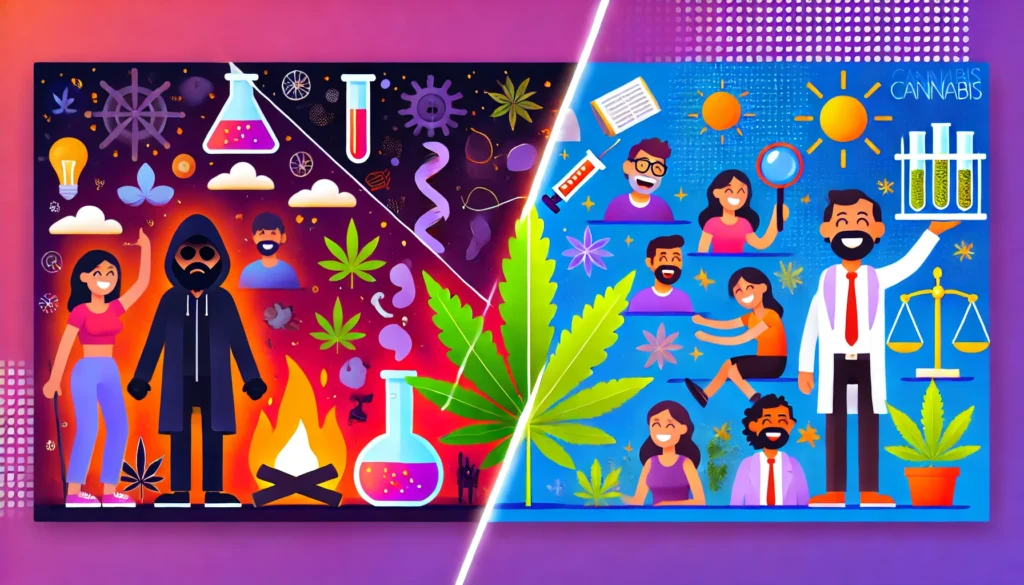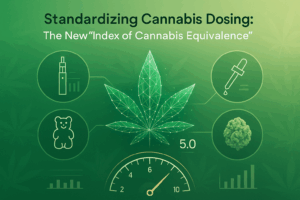These are the top 5 Myths About Medicinal Cannabis, Debunked, please pay special attention to the last one…
Myth vs. Fact: What Science Says About Cannabis Efficacy
Cannabis is often a hot topic of debate, and with that comes a whirlwind of myths and misconceptions. But what does science actually say about its effectiveness? Let’s separate the facts from fiction in a way that’s as enjoyable as it is informative.
- Myth: Cannabis is a Cure-All
Let’s start with the big one—does cannabis cure everything? The short answer is no, and the long answer is more nuanced. Cannabis has shown incredible promise in treating certain conditions, like chronic pain, epilepsy, and nausea from chemotherapy. But it’s not a miracle drug that can fix everything overnight.
For example, studies highlight the efficacy of cannabis for managing symptoms rather than curing diseases. Chronic pain? Cannabis can help reduce the discomfort. Anxiety? Certain strains might help you relax, but overuse can sometimes make things worse. It’s all about moderation and choosing the right product for your needs.
So, while cannabis can be life-changing for many, it’s important to view it as a tool rather than a universal remedy. Think of it like a hammer—it’s great for nails, but it won’t help you bake a cake.
- Myth: Cannabis Is Completely Harmless
There’s a common myth that cannabis is entirely safe and free of side effects. While it’s certainly safer than many substances, it’s not entirely risk-free. Science shows that excessive use can lead to issues like impaired memory, dependency, or even heightened anxiety in some cases.
The key is understanding your limits. For medicinal use, this means working with a healthcare provider to find the right dosage and strain. For recreational use, it means knowing when to stop. Think of it like chocolate—it’s amazing in moderation, but too much can make you feel not-so-great.
Another important point? Cannabis affects people differently. One person might find relief from migraines, while another could experience drowsiness. Listening to your body and starting with low doses can help you avoid unwanted surprises.
- Fact: Cannabis Helps with Chronic Pain and Inflammation
Here’s where science gets exciting. Studies consistently show that cannabis can be highly effective for managing chronic pain and inflammation. This is thanks to cannabinoids like THC and CBD, which interact with your body’s endocannabinoid system to regulate pain and reduce inflammation.
For patients dealing with conditions like arthritis, fibromyalgia, or multiple sclerosis, cannabis offers a natural alternative to heavy-duty painkillers. And the best part? It often comes with fewer side effects than traditional medications.
That said, not all cannabis products are created equal. Full-spectrum products, which include a variety of cannabinoids and terpenes, tend to be more effective than isolates. So, if you’re looking for relief, it’s worth investing in high-quality options.
- Myth: The Higher the THC, the Better
More THC equals better effects, right? Not quite. While THC is a key player in cannabis’s medicinal properties, it’s not the whole story. In fact, strains with balanced THC and CBD levels often provide more well-rounded benefits without the intense psychoactive effects.
Science suggests that the “entourage effect” plays a major role here. This is the idea that cannabinoids and terpenes work together to enhance the overall impact of cannabis. It’s like a band—THC might be the lead singer, but the other compounds are the backup vocals that make the song great.
So, don’t get caught up chasing the highest THC percentage. A little balance can go a long way toward making your cannabis experience more enjoyable and effective.
- Fact: Cannabis Supports Mental Health—But Carefully
Cannabis and mental health can be a tricky pairing. On one hand, studies show that cannabis can help with conditions like anxiety, PTSD, and depression when used responsibly. On the other hand, heavy or improper use can sometimes exacerbate these issues.
For instance, CBD is known for its calming effects, making it a go-to for managing anxiety. THC, on the other hand, can have different effects depending on the dose—small amounts may relax you, but too much could make you paranoid.
The takeaway? If you’re using cannabis for mental health, less is often more. Stick to strains and products known for their calming or uplifting effects, and always consult a professional for guidance.
- Debunking Stigma: The Science is Clear
One of the biggest myths about cannabis is that it’s a gateway drug or inherently dangerous. Thankfully, science has debunked this outdated notion. Studies show that cannabis is far less harmful and addictive than alcohol or tobacco, and it has significant medicinal benefits.
As legalization spreads, so does the opportunity for more research. With each new study, we’re gaining a clearer picture of how cannabis works and how it can help people. This growing body of evidence is helping to reshape perceptions and reduce stigma.
The Bottom Line
Cannabis isn’t a one-size-fits-all solution, but it’s a powerful tool when used responsibly and with the right guidance. By understanding the myths and facts, you can make informed choices and enjoy the many benefits this amazing plant has to offer.
So next time you hear a wild claim about cannabis, remember: science has the real answers. Let’s keep busting myths and spreading the facts—one bud at a time! 🌿
Can Cannabis Cure Everything? Understanding Its Limitations
Cannabis is often hailed as a wonder plant, and while it has some impressive medicinal benefits, it’s not a cure-all. Understanding what cannabis can and can’t do is key to managing expectations and using it effectively. Let’s explore its potential and limitations in a fun, easy-to-read way.
- The Hype: Why People Think Cannabis Is Magical
Cannabis has been making headlines for its ability to manage pain, reduce anxiety, and even control seizures. Stories of people finding relief when nothing else worked are truly inspiring, and they’ve helped boost the plant’s reputation.
But here’s the thing—sometimes the hype can outpace reality. It’s easy to think cannabis is the solution to every health problem when you hear so many success stories. While it’s true that cannabis has a wide range of applications, it’s not a one-size-fits-all remedy.
Think of cannabis like a Swiss Army knife: it has many tools, but it’s not the answer to every challenge. Knowing when and how to use it makes all the difference.
- What Cannabis Can Do Well
Let’s give cannabis credit where it’s due. Research shows it’s highly effective in managing certain conditions, especially chronic pain, nausea, and spasticity in diseases like multiple sclerosis. For people dealing with chemotherapy side effects or seizures from epilepsy, cannabis can be life-changing.
CBD, one of the key compounds in cannabis, is famous for its anti-inflammatory and calming properties. Meanwhile, THC can help with pain relief, appetite stimulation, and even improving sleep. These are powerful tools for improving quality of life.
But here’s the catch: cannabis works best as part of a broader treatment plan. It’s not meant to replace all medications or therapies. If you’re using it to manage symptoms, it’s important to work with a healthcare provider to ensure it complements your overall care.
- What Cannabis Can’t Do
While cannabis can work wonders in some areas, there are clear limitations. For one, it doesn’t cure diseases—it helps manage symptoms. If you’re dealing with a condition like diabetes, for example, cannabis won’t lower your blood sugar levels.
Another common misconception is that cannabis can fix mental health issues on its own. While it may help reduce anxiety or stress in some cases, it’s not a standalone solution for conditions like depression or PTSD. In fact, using too much THC can sometimes make anxiety worse.
And let’s talk about cancer. Cannabis is often discussed as a potential treatment, but the reality is it’s not a cure. It can help manage side effects of cancer treatment, like pain or nausea, but there’s no solid evidence yet that it eradicates cancer cells.
- The Importance of Realistic Expectations
Managing your expectations with cannabis is crucial. It’s easy to fall into the trap of believing it’s a miracle solution, especially when you see so many glowing testimonials. But every person’s body is different, and cannabis affects everyone uniquely.
If you’re new to cannabis, start small and pay attention to how it makes you feel. Be realistic about what it can achieve, and remember that it’s not a replacement for medical advice or treatment.
Cannabis is most effective when used mindfully. Think of it as a supportive friend on your health journey—not a superhero swooping in to save the day.
- How Science Is Helping Us Understand Cannabis Better
The good news? Research on cannabis is growing every day. Scientists are studying how cannabinoids like THC and CBD interact with the body to unlock new therapeutic possibilities. This means we’re getting closer to understanding where cannabis shines and where it falls short.
For example, researchers are exploring how cannabis might support conditions like Alzheimer’s, Parkinson’s, and even addiction recovery. While we’re not there yet, these studies highlight the plant’s untapped potential.
In the meantime, it’s important to rely on proven uses of cannabis while keeping an eye on future developments. As science catches up, we’ll have clearer answers about its capabilities.
- A Balanced View: Appreciating Cannabis for What It Is
At the end of the day, cannabis isn’t a magic potion—it’s a plant with incredible therapeutic properties. Appreciating it for what it can do (while understanding its limitations) leads to a more balanced and effective approach.
So, the next time someone claims cannabis can “fix” everything, you’ll know better. It’s not about curing all ailments—it’s about providing relief and improving quality of life where it can.
Whether you’re using it for pain, anxiety, or simply to relax, cannabis works best when you use it wisely. Celebrate its strengths, respect its boundaries, and keep learning as the science evolves. 🌿
THC and CBD: The Real Story Behind Their Effects
Cannabis is famous for its therapeutic and recreational uses, but have you ever wondered what makes it so effective? It all comes down to two powerhouse compounds: THC and CBD. These cannabinoids each play unique roles in how cannabis interacts with your body. Let’s dive into what they do and how they work together to create that magic.
- THC: The Star of the Show
THC (tetrahydrocannabinol) is the compound most people associate with cannabis. It’s the one responsible for that iconic “high” feeling. But THC isn’t just about fun—it also offers serious therapeutic benefits.
For starters, THC is excellent for managing pain. It binds to receptors in your brain and nervous system to reduce discomfort, making it a go-to for people dealing with chronic pain or recovering from surgery. It’s also great for stimulating appetite, which is why it’s often recommended for patients undergoing chemotherapy.
But THC has its quirks. In low doses, it can relax you, but too much can lead to anxiety or paranoia. That’s why starting small is always a good idea—you can enjoy the benefits without going overboard.
- CBD: The Calm Companion
CBD (cannabidiol) is THC’s mellow sibling. Unlike THC, CBD doesn’t get you high, but don’t let that fool you—it’s incredibly powerful in its own right.
CBD is best known for its calming effects. If you’re feeling anxious or stressed, CBD can help you chill without impairing your focus. It’s also a favorite for managing inflammation, which is why athletes and people with arthritis often turn to CBD for relief.
Another major perk? CBD can counteract some of THC’s side effects. Feeling a little too buzzy after taking THC? A dose of CBD can help bring you back to earth. It’s like the yin to THC’s yang, creating balance when you need it most.
- How They Work Together: The Entourage Effect
Here’s where things get really interesting: THC and CBD aren’t just great on their own—they’re even better together. Scientists call this synergy the “entourage effect,” and it’s why many cannabis products include both cannabinoids.
When THC and CBD team up, they enhance each other’s benefits while reducing unwanted side effects. For example, CBD can help take the edge off THC’s psychoactive effects, making the experience smoother and more enjoyable.
This balance is especially important for medicinal cannabis users. A product with a mix of THC and CBD can provide comprehensive relief for conditions like chronic pain, anxiety, or insomnia. It’s like having a dynamic duo working for your health.
- Choosing the Right Balance for You
Not all cannabis products are created equal, and finding the right THC-to-CBD ratio is key to getting the results you want.
If you’re looking for relaxation without the high, go for a CBD-dominant product. These are great for daytime use, especially if you need to stay focused while keeping stress in check.
On the other hand, if you’re dealing with intense pain or need help sleeping, a THC-rich product might be your best bet. Just remember to start with a low dose, especially if you’re new to THC.
For many people, a balanced product with equal parts THC and CBD is the sweet spot. You’ll get the benefits of both cannabinoids without feeling too high or too mellow. It’s all about experimenting to find what works best for your body.
- Debunking Myths About THC and CBD
Let’s clear up a few misconceptions. First, THC isn’t “bad” just because it’s psychoactive. While it does alter your state of mind, it also offers unique therapeutic benefits you can’t get from CBD alone.
On the flip side, CBD isn’t “weaker” because it doesn’t get you high. Its anti-inflammatory and calming properties make it a powerhouse for health and wellness.
The truth is, both THC and CBD have their strengths. Choosing between them (or using both) depends on your needs and goals.
- The Future of THC and CBD
As research on cannabis expands, we’re learning more about how THC and CBD work—and discovering new ways to use them. From specialized ratios tailored to individual conditions to innovative delivery methods like patches and inhalers, the possibilities are endless.
The real story behind THC and CBD is one of balance and potential. Whether you’re exploring cannabis for fun or wellness, these two cannabinoids are at the heart of what makes this plant so extraordinary.
So, next time you pick up a cannabis product, take a moment to appreciate the science behind it. THC and CBD aren’t just compounds—they’re your allies in wellness and relaxation. Cheers to that! 🌿
The Stigma of Cannabis Use: Breaking Down Barriers
For years, cannabis has been tangled in a web of misconceptions and stigma. But times are changing, and the conversation around cannabis is shifting. Whether for medicinal or recreational use, it’s time to tackle the outdated views and open up honest discussions about this remarkable plant. Let’s break down the barriers and embrace cannabis for what it really is.
- Where the Stigma Began
Cannabis hasn’t always had a bad reputation. For centuries, it was celebrated for its medicinal and industrial uses. So, how did things go wrong? Much of the stigma surrounding cannabis stems from decades of misinformation, fear-mongering, and misguided policies.
In the early 20th century, cannabis became associated with crime and social rebellion, thanks to media campaigns that painted it as a dangerous drug. The “Reefer Madness” era took things to a whole new level, convincing many people that cannabis was a threat to society.
Fast forward to today, and those stereotypes are still lingering. Many people still view cannabis use as irresponsible or harmful, despite mounting scientific evidence to the contrary. But the good news? These perceptions are starting to change.
- Cannabis Is Medicine, Not a Menace
One of the biggest breakthroughs in breaking down stigma is the recognition of cannabis as a legitimate medicine. For patients dealing with chronic pain, epilepsy, or chemotherapy side effects, cannabis isn’t a luxury—it’s a lifeline.
Scientific studies have shown that cannabis can manage symptoms like nausea, anxiety, and inflammation. These aren’t just anecdotal stories—they’re backed by real research. When you see how cannabis improves people’s quality of life, it’s hard to argue that it’s just a “bad habit.”
And let’s not forget CBD, cannabis’s non-psychoactive superstar. Products infused with CBD have gained mainstream popularity for their calming and anti-inflammatory effects, helping to normalize cannabis use in everyday life.
- Changing Minds, One Conversation at a Time
The stigma around cannabis won’t disappear overnight, but honest conversations can make a big difference. When you share facts, personal experiences, and success stories, you’re helping to educate those who may still have outdated views.
It’s important to approach these conversations with patience. Not everyone is ready to accept cannabis, and that’s okay. Focus on sharing what you know and listening to their concerns. It’s not about winning an argument—it’s about opening minds.
Pop culture is also playing a role in breaking down barriers. Movies, TV shows, and even wellness influencers are helping to show cannabis in a more positive light. Seeing characters or people you admire using cannabis responsibly can go a long way in normalizing it.
- The Role of Legalization in Reducing Stigma
Legalization has been a game-changer for how people view cannabis. In countries and states where cannabis is legal, the stigma is fading fast. When you can walk into a dispensary and buy cannabis like you would a bottle of wine, it’s hard to see it as something taboo.
Regulation also helps people trust cannabis more. Knowing that products are tested for quality and safety gives consumers peace of mind. It shows that cannabis isn’t part of some shady underground—it’s a legitimate, well-regulated industry.
Legalization also opens the door for more research. As studies continue to confirm the benefits of cannabis, it becomes easier to dispel myths and educate the public.
- Cannabis Users Come in All Shapes and Sizes
Another way to tackle stigma is to highlight the diversity of cannabis users. It’s not just college kids or stereotypical stoners enjoying the plant. Professionals, parents, athletes, and retirees are all turning to cannabis for different reasons.
Think about the mom using CBD to manage stress or the grandparent using THC for arthritis pain. These stories help break down the “lazy stoner” stereotype and show that cannabis is for everyone.
Cannabis use isn’t about escaping reality—it’s about enhancing well-being, whether that’s through pain relief, relaxation, or creativity.
- A Brighter Future for Cannabis
The stigma around cannabis is fading, but there’s still work to be done. By educating ourselves and others, we can continue to break down barriers and build a world where cannabis is respected for its many benefits.
Whether you’re a seasoned user or just curious, you’re part of the movement to normalize cannabis. Share your experiences, stay informed, and challenge outdated views when you can.
Cannabis isn’t something to hide or be ashamed of—it’s a plant with incredible potential. Together, we can change the narrative and ensure that cannabis gets the respect it deserves. 🌿




